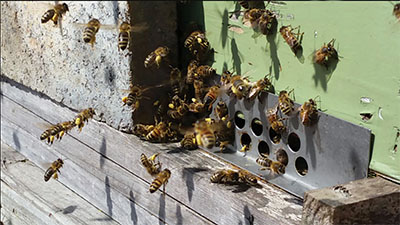
In December with the holidays upon us, spring seems a long way off. But for the bees, the spring starts weeks before the first snowdrops rear up through the frozen ground. As soon as the days start increasing in length again, the bees click into spring preparation mode.
By January many colonies have started brooding up again, tending a tiny batch of eggs, larvae and capped cells. Once brood rearing kicks off in the colony, the bees will start tearing through their honey stores. Even if it’s below freezing outside, the bees have to keep the brood toasty warm. Honey bees maintain stable brood nest temperatures of 33-36° C (91-97° F) even when outside temperatures sink far below zero. Generating heat requires fuel. Bees “shiver,” flexing their powerful wing muscles in the thorax without moving their wings to generate heat.
While all bees contribute to keeping the colony warm, they don’t all do their fair share. Individual bees can vary up to 54° F in temperature from each other. Some bees specialize in warming the brood nest. They sit on the capped combs, pressing their warm thorax against the brood cappings to transfer heat. A bee can generate up to 40° C or 104° F in her thorax. Using heat sensitive cameras you can see where such bees leave “hot spots” even after they get back up and move away.
In addition to warming brood from above, bees can climb into empty cells adjacent to brood. At first glance, it looks like they’re in there for a snooze, but in reality they transmit heat through the wax wall to the neighboring, sealed brood cells. They can be distinguished from resting bees, because they rapidly and continuously pump their abdomen, which researchers believe is due to their high breathing rate. Bees do similar pumping motions and rapid respiration when they’re warming up their flight muscles. Resting bees will also pump their abdomens, but often take long pauses.
So while it still feels like winter, the bees will soon be switching back into brood rearing mode. Be sure the colony has enough food stores, as a colony can quickly use up stores if they’re warming large brood surfaces when temperatures plummet. Erratic weather that cycles from cold to warm and back to cold again is especially hard on the bees, as they sometimes expand their brood nest too rapidly. ….


